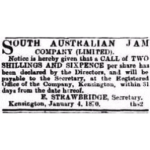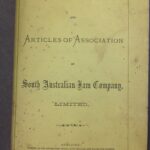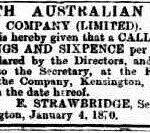On 28 September 1869, Mr T Collins held a meeting at the East-End Market Hotel to gauge interest among fruitgrowers and others interested in forming the South Australian Jam Company. Those present agreed to make jams, preserves, and pickles, and resolved to ‘commence practical operations before the next fruit season’. On 6 November that year, interested persons met again at the East-End Market Hotel, and elected directors: Richard Vaughan- who commissioned the Botanic Hotel and Chambers down the corner- Mr Clarke, Mr Ridgway, Mr Collins, and Mr Noices.
Development
In the 10 November issue of South Australian Register, the South Australian Jam company’s secretary, E Strawbridge, advertised the company’s need for a ‘competent working manager’; applications and testimonials were to be sent to the East-End Market Hotel within the next three days. On 4 June 1870, the South Australian Jam Company held another meeting at the hotel, but only 13 shareholders appeared, leaving the company one person short of the required 14 shareholders. Chairman Mr Collins waited for an hour before adjourning the meeting. The next week, on 13 June, the company had a successful meeting at the East End Hotel, with 15 shareholders present. ‘Calls and estimated proceeds of jam on hand’ revealed that the company had a surplus of £520 16s. 9d., however, Chairman Mr Collins indicated his disappointment in the lacking output and enthusiasm of the producers. Still, the company’s jam won first honours at the Prince’s Show that year, held in the Exhibition Building on the North Park Lands.
On 11 October, the South Australian Company met at the East-End Market Hotel after laying the foundation stone for their factory at the north side of the East-End Market. Before this, the organisation’s jams were made in Kensington. Secretary Mr Hammer declared that the company had manufacted over 130 000 lbs of jam in the past season, one third of which had been exported to England. While the jam company had become a great success, demand was greater than supply, so the proposed building of 60 feet by 25 feet would be a relief for suppliers and good news for the shareholders. At the London International Exhibition show of 1873, the South Australian Jam Company won a medal. At the Adelaide Show of 1874, the jam company earned two certificates of merit. On 6 June 1874, the South Australian Jam Company reconvened for their half-yearly meeting at the East-End Market Hotel. Secretary Mr Hammer reported that the company had produced more than 240 000 lbs of jam; however, since the company was running on borrowed money, profits from the season were only £6 000.
An 1874 South Australian Mail and Weekly Chronicle issue revealed that the company accounted for half of the strawberry crops from Flowery Vale gardens in the Mt Lofty ranges. The newspaper hinted at the company’s massive business in reporting that it would ‘have to pay Messrs A Simpson & Son about £1 600 for tins and Messrs Elder, Smith & Co about £2 000 for sugar’; the newspaper also revealed that the company’s main building, by the East-End Market, measured one hundred feet in length and forty feet in width. However, the company already needed more space and hoped to add to the building before next fruit season. The South Australian Mail and Weekly Chronicle detailed the process from picking fruit to packaging the jam:
When the fruit is first received it is carefully picked over. It is then put into the coppers, of which there are three, holding from 5 cwt. to 6 cwt. each, and heated by means of steam supplied by an engine. An ingenious contrivance has been adopted by which the boiling fruit is kept in constant motion. After the fruit has been converted into jam it is put into coolers, and then tinned; and the tins having been soldered, they pass into the hands of the cleaners and examiners, the latter of whom have instructions to be very particular in the performance of their duties. The tins are then labelled, papered, and packed in boxes… The Company are making 21 different kinds of jams, and with existing appliances they can turn out two and a half tons in a day.
The 1874 article also gave insight into the logistics of the South Australian Jam Company: the jam-making season lasts six months of the year, and during peak time thirty people are working at once. While the company wanted to start making sauces and pickles to keep a steady staff year-round, it would struggle to have enough suitable bottles for the additional products. In the last year, the South Australian Jam Company had exported between thirty and forty tons of jam to England, but because of considerably increased demand in Australia, company directors predicted exports would decrease. At the time of the article’s publication, the company had three directors: Mr Vaughan, Mr Ridgway, and Mr Kempson, while Mr Hammer served as secretary and Mr R Wallis as factory supervisor.
At the Victorian Intercolonial Exhibition of 1875 in Melbourne, the South Australian Jam Company’s exhibits won second prize. The South Australian Jam Company does not have historical records past the year of 1876, when Mr Kempson took the South Australian Jam Company to court for unknown reasons. The 16 May 1879 issue of The South Australian Advertiser announced that the South Australian Jam Company would auction off all items in their possession that day at 11 AM, which included: ‘3 large copper boilers, 1 300 gallon iron steam boiler, benches, machinery, fittings, tables, solder, trays, utensils, lot surplus jam tins, 67 large stone jam jars, about 2 tons Mauritius sugar, Avery’s weighing-machine, and large quantity of sundries’.







Comments